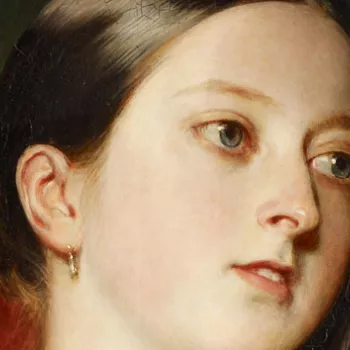Pair of candelabra 1848
Cut glass, giltwood base | 243.0 x 76.0 x 76.0 cm (whole object) | RCIN 41311
-
Pair of cut glass candelabra; each with fifteen branches in two tiers surrounding a facetted centre, the scalloped drip pans hung with wedge-shaped pendants, on prismatically cut shaft and baluster base with hexagonal lozenge-cut foot and scrolled foliate feet.
The firm of Osler, founded by Thomas Osler in Birmingham in 1807, was taken over in 1831 by his son Follett (1808-1903), joined later by his second son, Clarkson (1811-76). The business expanded rapidly with the acquisition of larger premises in Birmingham, the application of new technology, notably power-driven lathes to improve the precision and variety of glass-cutting techniques, and the lease of a London showroom (45 Oxford Street) in 1845.
Osler's creation of a pair of gigantic cut-glass candelabra, almost 17ft high, to stand either side of the tomb of the Prophet Mohammed, completed in 1847, brought the firm wide publicity and the attention of Prince Albert, whose interest in technological innovation was well known. This contact led in due course to the order for the Osborne candelabra, which were to be the Prince's birthday present to the Queen, on 24 May 1848. The candelabra were returned to London for temporary exhibition at Osler's, and three years later, they were included in the Great Exhibition (Official Catalaogue, vol.II, p.700, pl.118), together with one of the most sensational exhibits, Osler's celebrated 27ft glass fountain, which stood in the centre of the Main Avenue in the Crystal Palace. Osler's were awarded a Council Medal in Class 24.
The Osler firm later supplied the prismatic glass ceiling lights for the new Ball and Concert Room at Buckingham Palace and five similar lights for the Waterloo Chamber at Windsor Castle (RA MRH/SUPT WC/Bills, quarter to March 1862/8). Their work for the Queen also included a Tudor-pattern glass service for her son-in-law Prince Frederick William of Prussia (RA VIC/ADD T/232/169).
Text adapted from Victoria & Albert: Art & Love, London, 2010Provenance
Commissioned by Prince Albert and presented to Queen Victoria on her twenty-ninth birthday, 24 May 1848 (payment dated 1 November 1848, £238 17s 6d, PA Ledgers 1848/81)
[Victoria & Albert: Art & Love, London, 2010, pg 456] -
Creator(s)
(glass maker)(glass maker)Acquirer(s)
-
Medium and techniques
Cut glass, giltwood base
Measurements
243.0 x 76.0 x 76.0 cm (whole object)
Category
Object type(s)











